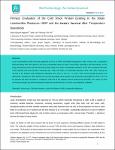




Lactic Acid Bacteria (LAB) have been approved by FDA as GRAS (Generally Recognized as Safe). Among LAB, Lactobacillus plantarum along with other species in the genus Lactobacillus shows its roles in many fields, especially in the food industry. In this study, the deduced amino acids of cold shock protein (Csp) in the strain Lactobacillus plantarum UL497 were compared with those of the reported cold shock proteins, including CspL, CspC and CspP of Lactobacillus plantarum NC8. Then, after freezing, the survival of the bacteria with temperature downshift from 30°C to 8°C for 2, 5 and 8 hours at the growing log phase was determined. In particular, after freezing, the survival percentage of the bacteria with temperature downshift from 30°C to 8°C at the growing log phase increased in comparison with that of the bacteria without temperature downshift. Also, based on these survival percentages, the effects of duration of cold shock on the bacteria’s survival were primitively evaluated.
Readership Map
Content Distribution


Lactic Acid Bacteria (LAB) have been approved by FDA as GRAS (Generally Recognized as Safe). Among LAB, Lactobacillus plantarum along with other species in the genus Lactobacillus shows its roles in many fields, especially in the food industry. In this study, the deduced amino acids of cold shock protein (Csp) in the strain Lactobacillus plantarum UL497 were compared with those of the reported cold shock proteins, including CspL, CspC and CspP of Lactobacillus plantarum NC8. Then, after freezing, the survival of the bacteria with temperature downshift from 30°C to 8°C for 2, 5 and 8 hours at the growing log phase was determined. In particular, after freezing, the survival percentage of the bacteria with temperature downshift from 30°C to 8°C at the growing log phase increased in comparison with that of the bacteria without temperature downshift. Also, based on these survival percentages, the effects of duration of cold shock on the bacteria’s survival were primitively evaluated.